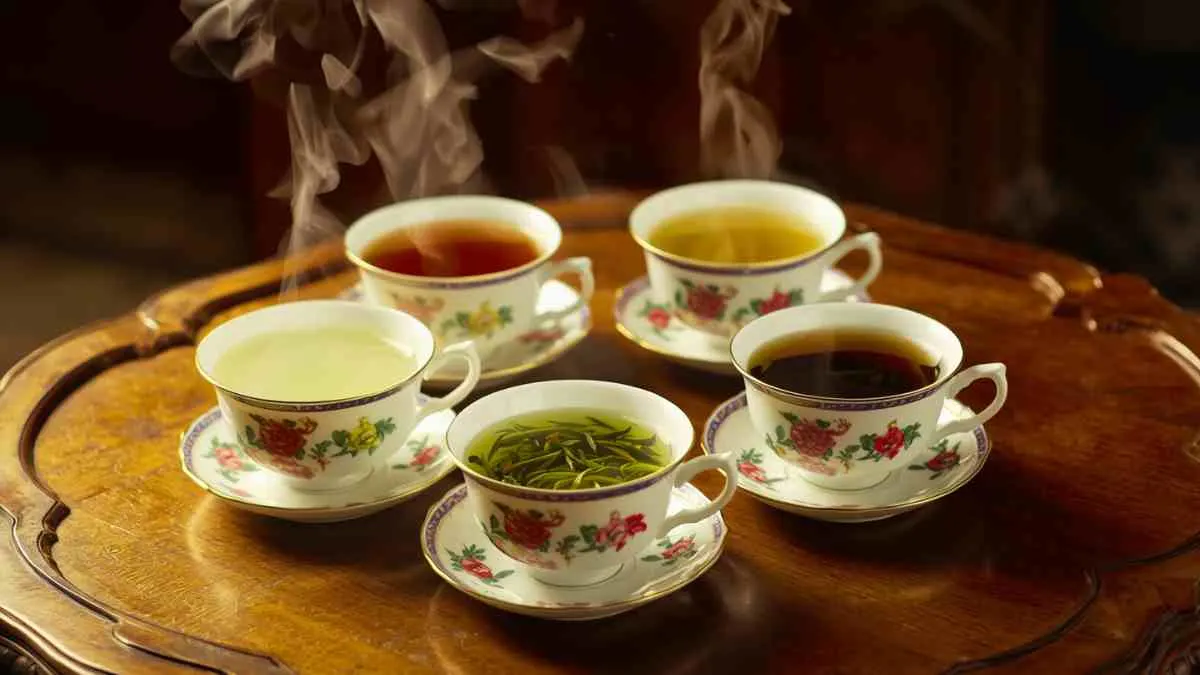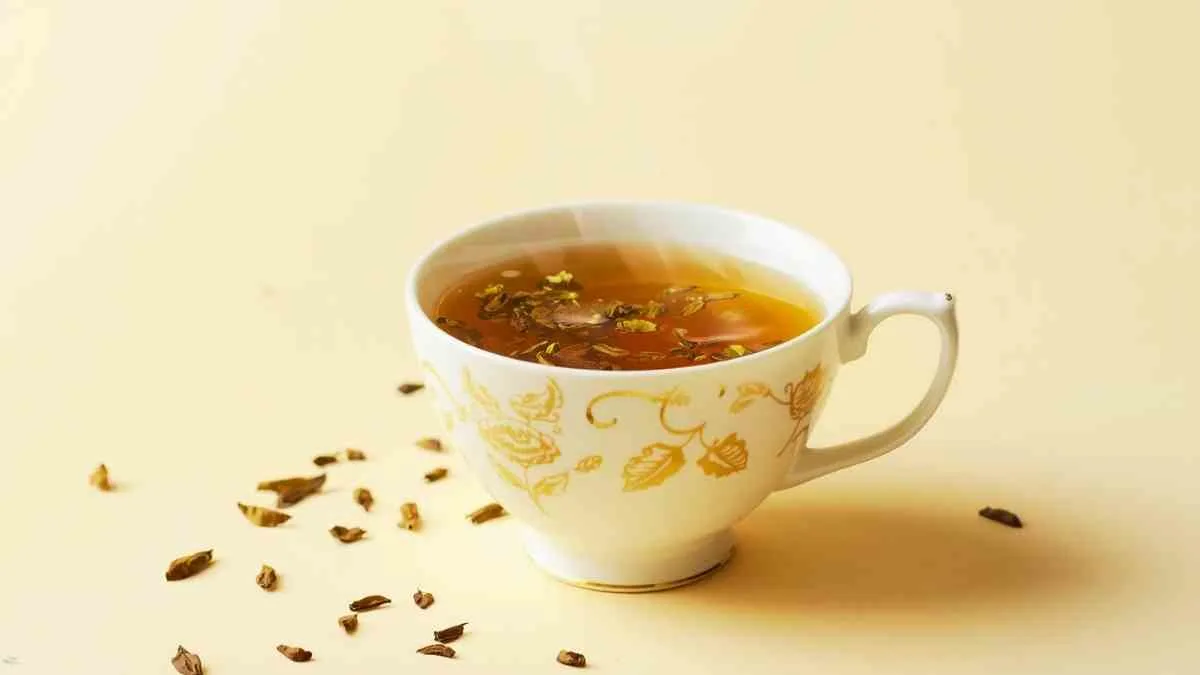Tea has been a cherished beverage for centuries, enjoyed across cultures for its rich flavors, calming properties, and numerous health benefits. But what truly makes tea extraordinary is its diversity.
The type of tea leaf used, how it’s processed, and how it’s brewed all contribute to the final flavor profile, texture, and health benefits of the cup.
In this comprehensive guide, we will explore the different varieties of tea leaves, provide you with five detailed tea recipes, and share expert brewing tips to enhance your tea experience.
Understanding Tea Leaves:

Tea leaves come from the Camellia sinensis plant, and the way the leaves are processed determines the type of tea. All types of traditional tea—black, green, oolong, white, and pu-erh—originate from this plant. The primary difference between these tea types lies in the oxidation or fermentation process, which influences the flavor and health benefits. Here’s a deeper look into the different types of tea leaves:
1. White Tea
-
Origin: White tea is made from the young buds and leaves of the Camellia sinensis plant. These buds are minimally processed, only withering and drying, which helps preserve their delicate flavors and high antioxidant content.
-
Flavor Profile: Subtle, sweet, and light with floral notes.
-
Health Benefits: White tea is rich in antioxidants like catechins, which have anti-inflammatory properties and may help improve skin health. It also has the lowest caffeine content among all tea types.
-
Popular Varieties: Silver Needle, White Peony.
2. Green Tea
-
Origin: Green tea leaves are quickly dried or steamed to prevent oxidation, which keeps the leaves green and preserves the natural flavors. The minimal processing results in a fresh, grassy flavor.
-
Flavor Profile: Fresh, vegetal, and sometimes slightly astringent or floral.
-
Health Benefits: Green tea is known for its rich antioxidant content, particularly catechins, which may aid in metabolism, help with weight loss, and promote heart health.
-
Popular Varieties: Sencha, Matcha, Dragonwell.
3. Oolong Tea
-
Origin: Oolong tea is partially oxidized, placing it between green and black tea. The leaves undergo a process of withering, rolling, and oxidizing, which results in a wide range of flavors.
-
Flavor Profile: It can range from floral and light to rich, creamy, and toasty.
-
Health Benefits: Oolong tea is said to boost metabolism and aid in fat oxidation, which makes it popular for weight management. It also helps improve mental clarity and digestion.
-
Popular Varieties: Tie Guan Yin, Da Hong Pao.
4. Black Tea
-
Origin: Black tea is fully oxidized, which gives it a darker color and stronger flavor. The leaves are allowed to wither, roll, oxidize, and then dry, resulting in a bold, robust tea.
-
Flavor Profile: Full-bodied, malty, and sometimes smoky, with varying levels of astringency.
-
Health Benefits: Black tea contains compounds known as theaflavins and thearubigins, which are antioxidants that support cardiovascular health. It also has higher caffeine content, making it a popular choice for energy.
-
Popular Varieties: Assam, Darjeeling, Earl Grey.
5. Herbal Tea (Tisane)
-
Origin: Herbal teas are not technically made from the Camellia sinensis plant but are infusions of herbs, flowers, spices, or fruits. Popular herbal teas include chamomile, peppermint, and rooibos.
-
Flavor Profile: Varies widely depending on the ingredients, from floral to spicy or fruity.
-
Health Benefits: Herbal teas are known for their soothing properties. Chamomile helps with relaxation and sleep, while peppermint is great for digestion, and rooibos is rich in antioxidants and can support skin health.
-
Popular Varieties: Chamomile, Peppermint, Rooibos, Hibiscus.
Step-by-Step Tea Recipes:
1. Classic Green Tea
Ingredients:
-
1 teaspoon loose-leaf green tea
-
8 oz water
Instructions:
-
Heat water to 175°F (80°C). If you don’t have a thermometer, bring the water to a near-boil, then let it cool for about 30 seconds.
-
Place the green tea leaves into an infuser or teapot.
-
Pour the hot water over the tea leaves and steep for 2–3 minutes. Avoid steeping for longer as this can cause bitterness.
-
Remove the tea leaves and serve the tea.
Tip: For a refreshing twist, add a slice of lemon or a few fresh mint leaves.
2. Chai Latte
Ingredients:
-
1 cup water
-
1 cup milk (or dairy-free alternative)
-
1 tablespoon loose-leaf black tea (or 1 black tea bag)
-
2–3 crushed cardamom pods
-
1 cinnamon stick
-
2–3 cloves
-
1–2 slices of fresh ginger
-
Sweetener to taste
Instructions:
-
Combine water, spices, and fresh ginger in a saucepan. Bring to a boil.
-
Add the loose-leaf tea (or tea bag) and let it simmer for 5 minutes.
-
Add milk and sweetener, and continue heating but do not let it boil.
-
Strain into a mug, and serve with a sprinkle of cinnamon or a cinnamon stick.
Tip: Froth the milk before adding it to the tea for a creamy texture.
3. Iced Hibiscus Tea
Ingredients:
-
1 tablespoon dried hibiscus petals
-
8 oz boiling water
-
Sweetener to taste
-
Ice cubes
Instructions:
-
Steep the hibiscus petals in the boiling water for 5–10 minutes, depending on how strong you want the flavor.
-
Strain the tea into a container and allow it to cool to room temperature, then refrigerate it.
-
Once chilled, serve over ice and sweeten to taste.
Tip: Garnish with lime slices or mint leaves for an extra touch of flavor.
4. Lemon Ginger Herbal Tea
Ingredients:
-
1 teaspoon dried ginger root
-
1 teaspoon dried lemon balm or lemon verbena
-
8 oz boiling water
-
Honey to taste
Instructions:
-
Combine the dried ginger and lemon herbs in a teapot.
-
Pour the boiling water over the herbs and steep for 5–7 minutes.
-
Strain the tea into a cup and sweeten with honey as desired.
Tip: For extra flavor, add a slice of fresh lemon.
5. Matcha Latte
Ingredients:
-
1 teaspoon matcha powder
-
2 oz hot water
-
6 oz milk (or dairy-free alternative)
-
Sweetener to taste
Instructions:
-
Sift the matcha powder into a bowl to avoid clumps.
-
Add the hot water and whisk until frothy using a bamboo whisk (or any small whisk).
-
Heat the milk in a saucepan, then froth it until it’s creamy.
-
Pour the matcha into a cup, then top with the frothed milk and sweeten to taste.
Tip: Use a matcha bowl (chawan) and whisk (chasen) for an authentic preparation.
Tips for Brewing Loose Leaf Tea:
-
Measure Tea Leaves Correctly: Generally, use 1 teaspoon of loose-leaf tea per 6 oz of water. For stronger tea, increase the quantity slightly.
-
Water Temperature Matters: Different teas require different water temperatures:
-
Green Tea: 170–180°F (77–82°C)
-
Black Tea: 200–212°F (93–100°C)
-
Oolong Tea: 190–205°F (88–96°C)
-
White Tea: 160–170°F (71–77°C)
-
-
Don’t Over-Steep: Steep your tea for 2–5 minutes, depending on the type. Over-steeping can make tea bitter, especially green tea.
-
Use Fresh Water: Always use fresh water for brewing tea. Water that has been boiled previously may lose oxygen and not extract the best flavor.
-
Proper Storage: Keep your tea leaves in an airtight container away from light, heat, and moisture to preserve their flavor and potency.
Recommended: WOW Tea | Benefits, Ingredients, and How It Works
Frequently Asked Questions:
1. Can I reuse loose leaf tea leaves?
Yes, many high-quality loose-leaf teas can be steeped multiple times. Adjust the steeping time for subsequent brews, as the leaves will release their flavors more quickly.
2. How do I make iced tea from loose leaf tea?
Brew the tea as usual, then allow it to cool and refrigerate. For a faster method, brew double strength and pour over ice.
3. Are there health benefits to drinking tea?
Yes, different types of tea offer various health benefits. Green tea is rich in antioxidants, while herbal teas like chamomile are known for their calming effects (webmd.com).
4. How do I prevent tea from becoming bitter?
Avoid over-steeping and ensure the water temperature is appropriate for the tea type. Using a timer can help ensure the correct steeping time.
5. Can I add milk to green or black tea?
Yes, milk can be added to green or black tea. However, some studies suggest that milk may reduce the antioxidant properties of green tea (health.com)

